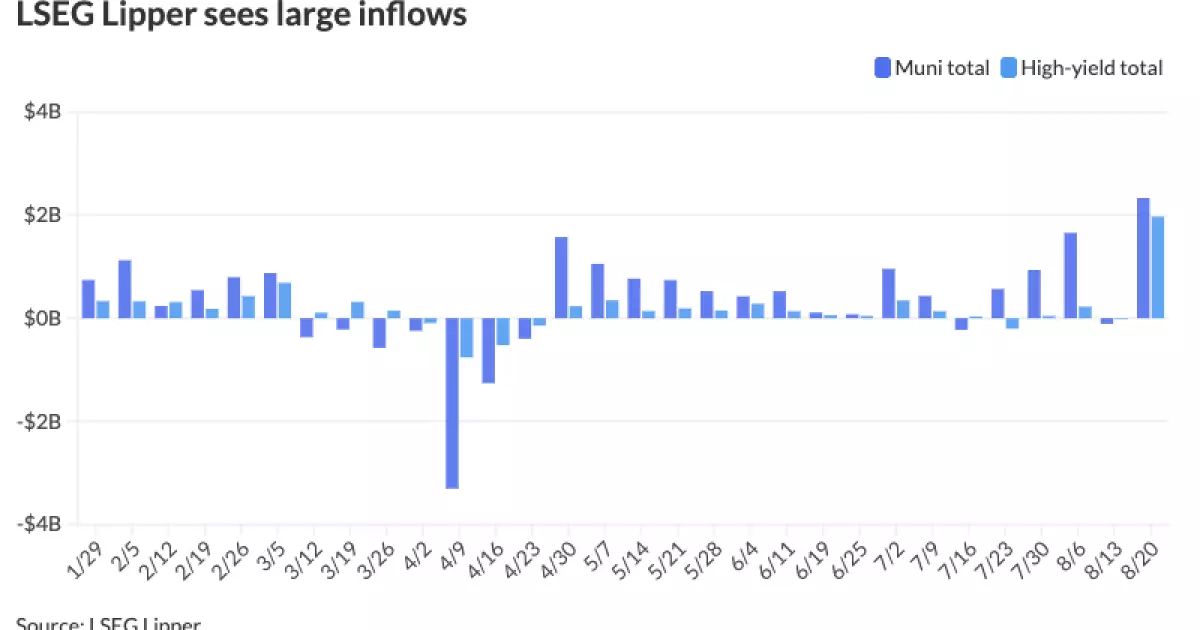The recent surge of over $2 billion into municipal bond mutual funds has sparked optimism among investors and industry insiders alike. This inflow marks the largest in more than two years, suggesting renewed confidence in the municipal market’s stability. At first glance, such enthusiasm appears to validate the narrative that munis are resilient, especially amid turbulent economic waters. However, a deeper examination reveals an underlying vulnerability that mandates a cautious approach. Cash is pouring into high-yield municipal ETFs and mutual funds, driven largely by reallocations from sophisticated institutional players seeking higher yields as traditional safe havens—like U.S. Treasuries—become more expensive and less appealing.
Yet, this flood of capital also signals an overstretched appetite for risk. The aggressive interest in high-yield munis, especially long-term ETF holdings, indicates that investors are chasing yield in a context where fundamental economic conditions remain uncertain. Such flows have the potential to create dislocations in the market, as funds pile into marginal credits or extend durations further than prudent, premised on the assumption of continued stability. Historically, large and rapid inflows in periods of technical strength often precede corrections, especially when macroeconomic fundamentals begin to falter. The risk here is that markets are building a fragile edifice, relying on the illusion that recent inflows will persist indefinitely without consequence.
Market Mechanics and the Danger of Overconfidence
Looking beyond the surface, the market’s technical backdrop paints a slowly warming picture but with ominous warning signs lurking beneath. The municipal-to-U.S. Treasury ratios—particularly at the 30-year (near 94-95%)—suggest that munis are becoming increasingly expensive relative to Treasuries. This trend might tempt investors to extend durations, but such decisions inevitably amplify interest rate risk, especially heading into a period of potential Federal Reserve rate cuts.
The market’s current steadiness largely stems from a subdued calendar and limited new issuance, which presently limits supply-side pressure. Still, these conditions could change abruptly, especially as upcoming redemptions—estimated at $17 billion in September—may prompt a rush of forced sales or rebalancing. Furthermore, the often-overlooked technical factors such as fund flows into money market funds—already at their lowest capacity since mid-April—highlight a precarious liquidity environment. As yields on floating rate money funds hover above fixed coupons, there may be a shift in investment preferences, especially if investor sentiment shifts toward expecting rate cuts.
These technical nuances, when combined with a fragile macroeconomic outlook, create an environment ripe for volatility. The belief that the market can continue its upward trajectory indefinitely ignores the risks intrinsic to such a crowded trade. If sentiment turns, the correction could be abrupt and painful, challenging the narrative of unassailable strength in municipal assets.
The Political and Policy Implications of a Volatile Market
Underlying these financial dynamics is a complex web of political and policy considerations that could significantly influence the market’s future. The upcoming Federal Reserve policy decisions, especially the possibility of rate cuts in response to softening inflation figures, remain a pivotal factor. Historically, September has been an unpredictable month for markets, with average losses of 1.3% since 2020, further complicating the outlook.
From a centrist perspective—leaning toward center-right liberalism—the current market environment presents a dilemma. On one side, the pursuit of yield driven by low-interest-rate policies and macroeconomic softness incentivizes investors to take on greater risk, potentially undermining financial stability. On the other, rising political pressures—whether from budgetary constraints, debt ceiling debates, or local government financial strains—pose systemic threats if munis start to exhibit signs of stress.
It’s evident that policymakers are walking a tightrope. Easing monetary policy to sustain market liquidity may offer temporary relief but risks igniting inflation or creating asset bubbles. Conversely, aggressive rate hikes could trigger market corrections and strain local governments’ ability to meet debt obligations. For investors, the challenge lies in navigating this delicate terrain without succumbing to complacency or panic.
The federal government’s stance on fiscal stimulus and infrastructure spending also bears considerable weight. Increased federal support can bolster municipal credits, but entitlements and grants are often politically contentious, especially as public debt continues to swell. The interplay of local economic health, federal policy, and investor sentiment will decisively shape the market’s trajectory in the months ahead.
In sum, while recent inflows into municipal funds paint a picture of optimism, they should not obscure the fundamental vulnerabilities brewing beneath the surface. The market’s technical strength, driven by leveraged flows and low yields elsewhere, remains fragile and susceptible to sudden shifts. For investors anchored in centrist, pragmatic values—favoring cautious stewardship over reckless chasing of yields—there’s an imperative to remain vigilant.
The challenges posed by upcoming policy decisions, fiscal pressures, and liquidity constraints suggest that a prudent approach in the near term is wise. As the market braces for potential turbulence, the illusion of safety embedded in recent gains risks blinding investors to the possibility of a sharp reversal. Balancing yield with risk, and fundamentals with technical signals, remains the central challenge for those navigating the evolving landscape of municipal bonds and government debt.

